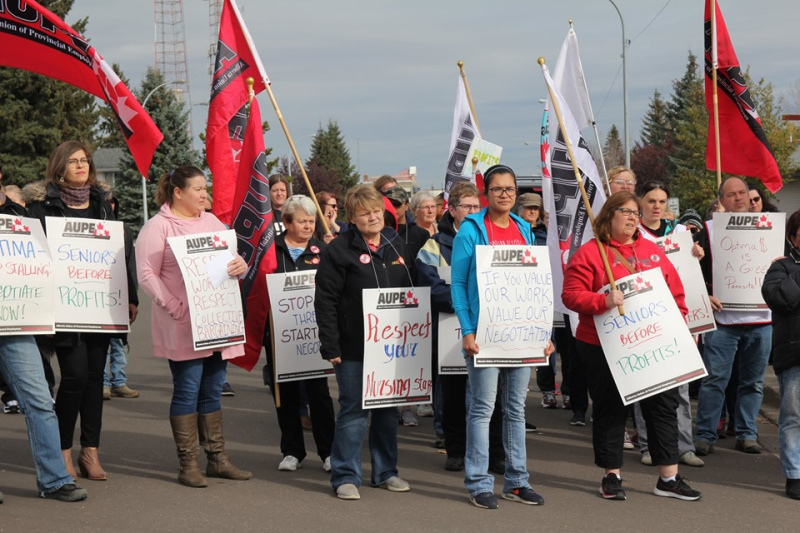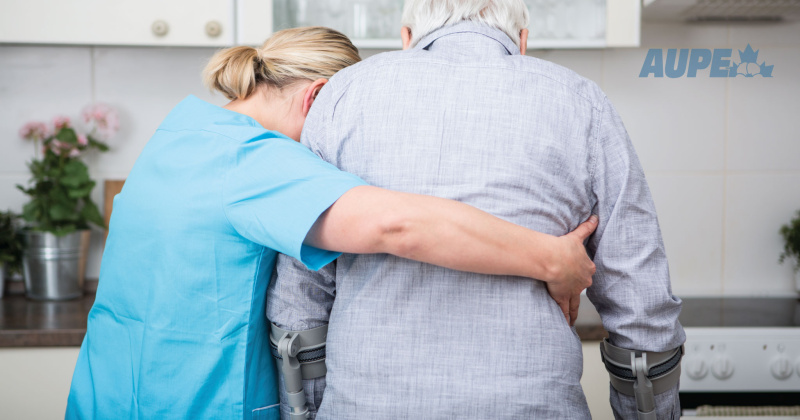Millionaires behind Alberta's private-care homes are on a sinking ship
And the UCP are dragging down our health-care system to try and save them.
Jul 28, 2020
by Celia Shea, Communications Staff
Watching the UCP throw another lifeline to the private continuing-care industry is a bit like watching a self-proclaimed DIYer fix everything with duct-tape. You can conceal the wear-and-tear, but if you don’t tackle the root of the problem, it will continue to grow and resurface.
This is exactly what’s happening in Alberta’s privately run long-term care (LTC) and supportive living homes right now.
While this industry has been awash with issues for decades, today COVID-19 has exacerbated these problems to the point of no return. And the stop-gap measures the UCP are using to cover the holes are being revealed for what they are: a last ditch, duct-tape effort that’s putting seniors, the disabled and the chronically ill at risk.
Unequal top-ups for equally essential work
One of these holes is the pay gap between workers.
In May, the UCP made a show of closing the gap by introducing a temporary $2/hr wage top-up for private sector health-care aides (HCAs) during the pandemic.
“It was a shaky performance at best,” says AUPE Vice-President and HCA Bonnie Gostola. “Not just because hoards of employers withheld the bonus for weeks and cherry-picked who got it, but also because the move left a lot of Albertans asking, ‘why now? Why not everybody else?’"
Most Alberta Health Services (AHS) workers across classifications haven’t seen a wage increase in three years, despite the rising cost-of-living.
In private, for-profits, where operators drive down working conditions to drive up their bottom-line, some housekeeping staff – the employees killing the coronavirus – start as low as $15.45/hr. Laundry workers and kitchen staff are in the same boat.
That’s barely minimum wage. And never mind the money: most Casuals don’t even get benefits or paid sick days.
As outrageous as this is, Gostola says, “the point isn’t about who is making less than the next person. The goal of pay equity is not to ensure all working people are paid equally bad. Alberta’s HCAs need a raise, but not because they earn less than LPNs. They need it because their work is critical to the functioning of the system as a whole. The same goes for all of their coworkers.”
Why push a hospital bed or clean rooms infected with deadly viruses when you can follow the money and go into a minimum wage gig, earning tips? Why study to be an LPN when two more years of school will get you an RN degree? All things told, gaps in staffing and specialized knowledge will widen.
An LPN can't focus their attention on dressing a patient's wounds, say, without an HCA to support with daily aides, like bathing. An HCA in a hospital might not be able to move a patient without a porter, and so on. When you remove one person from the care network, the whole operation collapses.
“Similarly, when one employee gets a wage top-up and another doesn’t, it lays bare the meagre income all healthcare workers are making,” says AUPE Vice-President Susan Slade, who has worked as an LPN for a decade.
No one wants a dead-end job, but that’s how Albertans will view these professions, she says.
“Why push a hospital bed or clean rooms infected with deadly viruses when you can follow the money and go into a minimum wage gig, earning tips? Why study to be an LPN when two more years of school will get you an RN degree? All things told, gaps in staffing and specialized knowledge will widen. And it won’t just be in healthcare,” she adds.
Many AUPE members working in provincial government services, municipalities and boards & agencies have been deemed essential workers during the pandemic, yet none of them have received a top-up. Now more than ever, they’re frustrated.

More hours for some but not enough staff to do the work
If the $2 fiasco didn’t demonstrate how little the UCP know about the realities of Alberta’s flailing healthcare system, the government’s single-site order certainly did.
The order determined how Alberta would bridge the gaps in care when all the continuing-care employees who worked multiple jobs, limited their employment to one site, to help stop the spread.
“Unfortunately the order failed to acknowledge that the UCP were playing with a puzzle that’s missing key pieces – bodies!” Says Slade.
This was proven when almost a month into the single-site mandate, AHS exempted four sites in Vegreville from the Order because there were too few staff to limit employees to one location.
Clearly employers would much rather share employees, forcing them to work precarious part-time positions, than provide solid full-time hours to more Albertans
This came as little surprise to AUPE members. Last year, 53 workers lost their jobs at one of these Vegreville homes, when the employer decided to subcontract out their work and offer positions back at up to $8/hr less. Most staff didn’t return.
One pre-pandemic benchmark study shows 4.1 hours of direct care per resident, per day are needed to maintain health. According to The Parkland Institute, AHS is almost there, with 4.0 hours of care provided on average, but the competition-driven private sector (which represents a disturbing proportion of beds) is averaging 3.1 hours or less.
“Clearly employers would much rather share employees, forcing them to work precarious part-time positions, than provide solid full-time hours to more Albertans,” says Gostola.
Today, the pandemic means even more work is landing on the same number of shoulders (minus those who get sick with COVID).
“Sure, employers are obligated under the single site order to give staff full-time hours in lieu of their lost part-time, casual or even full-time jobs, but this will hardly be enough to keep up with yesterday’s workloads, never mind today’s,” says Slade.
“And what about the employers who offer less competitive wages and consequently lose casuals and part-timers to other sites?” echoes Gostola. “Will these employers make up the difference by offering more hours to their regular staff? Will they hire more people? And even if they did, will they retain them?”
If the answer to all these questions is no, these facilities could bring to bear all the missed breaks, missed baths, and missed hours of care that thus far have been spread across hundreds of private continuing care homes. Packed into a few homes, these small cracks will be revealed for their big aggregate effect: a gaping hole in Alberta’s care system.

Bailouts for millionaires and pennies for the public
To add insult to injury, on May 19, the Alberta government announced a monthly reward of $14-million for private providers.
“While this money is needed for staffing and supports, when it’s provided without any requirement to suspend profits and bonuses of operators, it amounts to a corporate bailout,” says Gostola.
Since the pandemic started, continuing-care home owners have been profiting off of this crisis, collectively raking in billions, with CEOs, like the ones heading Chartwell and Extendicare, getting compensation in the millions.
“At any point during the COVID outbreaks, they could have forgone their bonuses to save their businesses – or better yet, to put their money where their mouth is and treat their sites like healthcare facilities rather than investments – but they didn’t.”
In May, when there were a total of 31 outbreaks reported at continuing care homes, over 80 per cent were in the private sector. Still, the UCP continued to reward these businesses with financial support.
The bonus comes only months after budget 2020 cut $26 million from the public system’s support services and slashed acute-care funding because, according to Premier Kenney, Alberta had to tighten its belt.
“Apparently this rule only applies to everyday Albertans, not the richest of the rich,” adds Slade.
The UCP might tout themselves as job creators and working class allies, but even in a pandemic this remains to be seen.
While the private sector was designed to benefit only a few, the public sector has the capacity to benefit everyone equally – that is, if it’s not used like a slush fund for corporate interests.
AUPE members across the province are joining hands with their neighbours to call on the UCP to take profit out of healthcare and bring all facilities into the public system. Join the movement. Call or email the Minister Shandro at 780-427-3665 or [email protected] to have your voice heard.